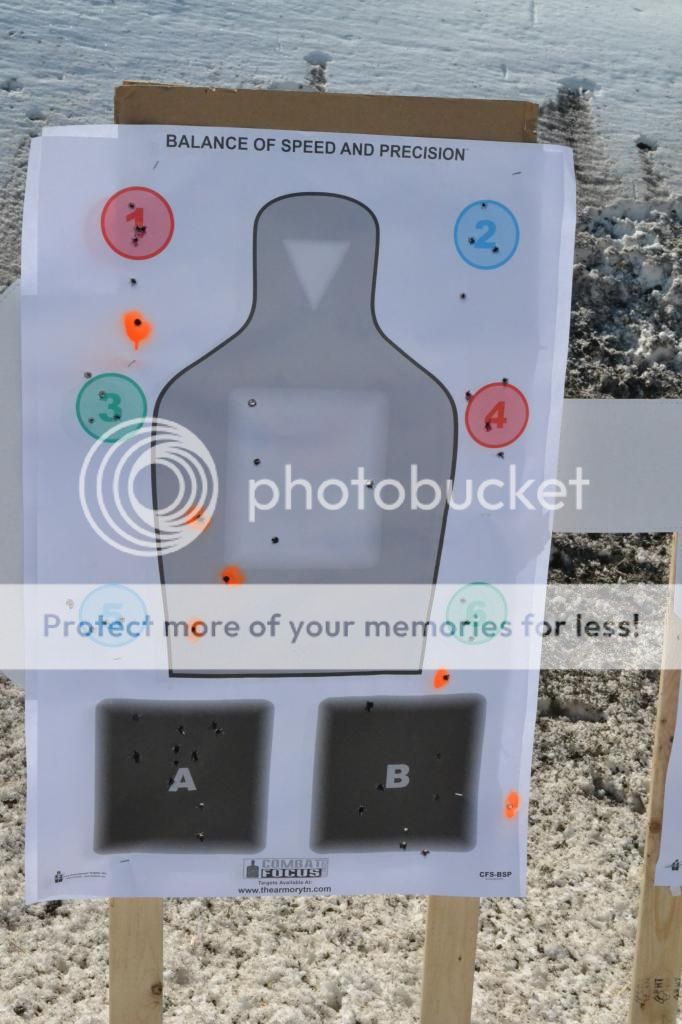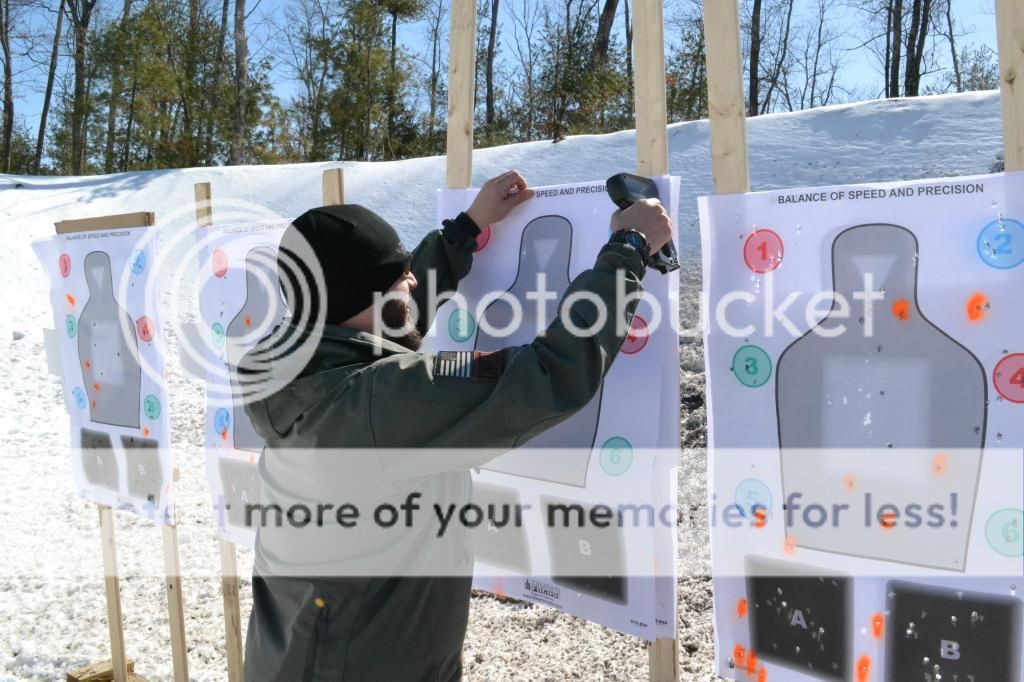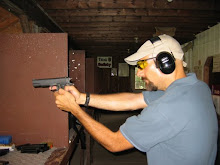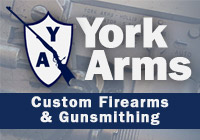Yesterday I had the privilege and good fortune to attend the Fundamentals of Combat Focus Shooting course offered by the good folks at Down Range Firearms Training. This was the first organized training course I've attended after being a shooter for nearly 25 years, and it was an eye-opener to say the least. The idea behind CFS is to train for the day we all hope will never come - the day we have to use our firearms in self-defense.
The course itself is very lean - this is a good thing - the basics are taught and practiced; the next skill set is introduced; the basics are reinforced. The stance - a modified Isoceles of sorts - is designed for stability; the upper body is positioned for maximum stability for both the shooter and for the shooting. It's a position that allows for mobility as well as "combat accurate" shooting - a phrase that has earned some well-deserved scorn for overuse, but is spot-on here.
The goal as they phrase it is "The Balance of Speed & Precision" - the shooter should go as fast as they can accurately place rounds on target. While a tight group is desirable for a bullseye shooter, in a defensive scenario it indicates that the shooter should speed up somewhat. The goal is to keep all shots inside the center of the target:
The numbers, well, those are where the precision comes in. The two lower boxes are for multiple aggressor scenarios as well as providing additional target boxes.
Oh, and Matt insisted I take this shot, for some reason:
He said something about people not believing he stapled targets...
Once we worked on the basics - the ready position, the stance, the presentation, etc. - we worked on building speed without sacrificing precision using a combination of different drills, each building on the previous lesson. All of the lessons taught are intuitive, once pointed out, and all make good sense in the context of dealing with a dynamic critical incident.
One of the hardest things for me to get used to - and this is something that is absolutely critical in such an instance - is moving while on the firing line. I commented during the debriefing that I'd been shooting for nearly 25 years now, and this was the first time that I'd shot and moved (Not shooting while moving; that's another course and one I hope to attend in the future). It dawned on me that all of my shooting had been done stationary, with either a bench in front of me or a static firing line.
Getting the movement down - from the "flinch" at the onset of the incident (because, honestly, in real life that's going to happen when you're surprised by a goblin); moving before firing to present a more difficult target to your assailant to moving while reloading - was the hardest part for me to incorporate. I envy the guys that had only recently started shooting - they had nowhere near the decades of institutionalized calcification I had and were able to more seamlessly integrate the concept of motion.
After lunch, with the basics well in-hand, we added more skills like the dynamic reload:
Everything makes sense. Bringing the firearm into the body helps improve stability and make it harder to reach; using both hands in concert facilitates a faster reload; "slingshotting" the slide rather than hitting the slide release is both simpler as well as providing a bit more power to the reload. Simple, intuitive, efficient. The entire course is like this. The hardest part was not looking at the gun while reloading - and this makes absolute sense in a life-or-death situation - you take your eyes off your assailant and you're in grave danger.
Form was critiqued in the "push your limits" drill:
The last set involves hitting the bottom circle as fast as possible. Yes, the distance is very close - approximately 3 yards - but
Towards the end of the day, everything gets pulled together for the "Figure 8" drill. Basically, the targets are set up in close to a 180º arc, and the shooter approaches the line walking a "figure 8" when one of the targets is called out. The shooter is to stop, identify the proper target, present their firearm, and shoot 2-5 rounds to neutralize the threat. Once this is done. the shooter scans the area, holsters, then resumes the figure 8. Here's one in action:
Yeah, it looks kinda funny. It feels like nothing I've ever experienced. Yes, you're still shooting paper targets - but there's that element of the unknown. In that split second that the target is called - and in my case, for example, the target was called as "number of kids you have" - you need to find the right target, present your firearm, line up and take the shot, scan for further threats, and then re-holster. It's a lot to process, and if it wasn't so intuitive it would be a daunting task indeed. Here's a closeup of the targets:
They're all like that. You need to be able to process the information quickly; assume the proper stable stance; present your firearm in a fluid and efficient motion; acquire sight picture; fire - possibly including a reload on the move - and continue scanning for additional threats. Every single shooter ran the figure 8; every single one of us made multiple mistakes in the course of the 3(ish) minute drill.
For the curious, my big mistake was that I neglected to chamber a round when stepping up to the line - despite being given a clear opportunity to do so. It had a full magazine inserted but no round chambered - and the time spent watching others perform the figure 8 drove the fact that I had inserted a loaded magazine without chambering a round right out of my brain. I compounded my error by not running a full tap-rack malfunction set - because I *knew* that it was simply a case of not chambering. Point, though, was that it *could* have been a dud round or another error, and the tap-rack would have fixed that.
I learned a *ton* from this course, folks. If you've only shot at a bench or static shooting line, it is a completely different world. Incorporating motion; a different stance (I'd been a classic Weaver stance shooter for most of my time behind the trigger); balancing speed and precision; bringing it all together was difficult - but the crew from DRFT made it interesting, attainable, and informative. At the end, there were a bunch of tired but happy people:
I can't say enough good things about the excellent training opportunity with Down Range Firearms Training - thanks Ian, Jim, and especially Matt!
That is all.
Subscribe to:
Post Comments (Atom)











7 comments:
I always encourage people to try IDPA or some other shooting game league so they can get a feel for moving and shooting under time constraints.
Once you do that you'll never be happy standing and shooting at a bulls-eye ever again.
It's a TON more applicable to a real-life scenario, that's for certain.
I think the single biggest thing I came away with is the idea of movement while shooting. It's hard to break > 2 decades of static shooting!
Shooting an IDPA match or three will get you more used to shooting and moving. It's not the real thing (what is?), but it's good artificial stress on you and your equipment.
Ditto the IDPA suggestion for much the same reasons you mention.
That "figure 8 drill" looks interesting; I'm going to pass it along to the local club to see if they can adapt it to match conditions. They're inventive fellows, it'll be fun to see what they come up with that fits inside a 25 yard indoor range.
Jay,
What pistol did you choose to use for the course?
The old adage was if you move 3 feet off the line of attack you decreased your chance of being hit by 90%.
Gerry
Glad you made it out Jay. I hope my mustache had a nice time!
Post a Comment